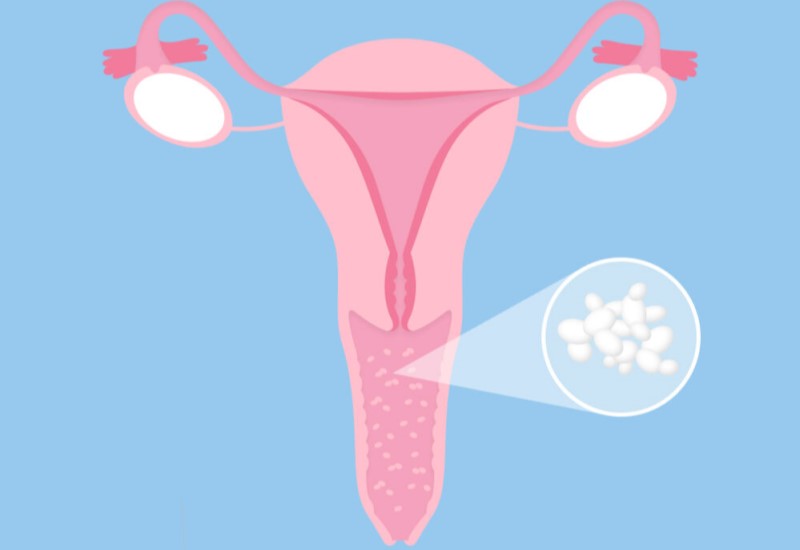Vaginal yeast infections, a common condition affecting women’s reproductive health, occur when the balance of bacteria and yeast in the vaginal environment is disrupted. Delving into the root causes of these infections facilitates easier treatment, prevention, and maintenance of vaginal health. Explore the insights below to grasp the factors contributing to vaginal yeast infections and their associated issues.
1. What is a Vaginal Yeast Infection?
Vaginal yeast infection, prevalent among women, arises when the balance of bacteria and yeast in the vagina is disturbed, fostering favorable conditions for the overgrowth of Candida albicans, commonly known as yeast. Symptoms commonly experienced by women with yeast infections include:
– Itching and discomfort
– Redness and swelling in the vaginal area
– Increased discomfort and soreness
– Pain during urination and sexual intercourse
– Changes in vaginal discharge, becoming thicker, whitish, and more abundant
– Untreated infections may lead to rashes and swelling around the genital area.

A vaginal yeast infection is caused by an overgrowth of a fungus called candida
Early recognition of yeast infection symptoms and timely medical examination are crucial for prompt treatment, enabling women to swiftly alleviate discomfort that may impede daily activities and quality of life. If experiencing any of the mentioned symptoms, especially if they persist or recur frequently, seeking immediate consultation with a gynecologist is advisable.
2. Causes of Vaginal Yeast Infections
Several factors contribute to the imbalance in the vaginal environment, leading to vaginal yeast infections. The primary causes include:
– Improper genital hygiene practices: Both inadequate or excessive hygiene practices can disrupt the natural balance in the vagina, creating favorable conditions for yeast growth.
– Inappropriate underwear selection: Tight-fitting, non-breathable underwear or those that do not absorb sweat effectively can increase moisture in the genital area, creating an ideal environment for yeast growth.
– Unsafe sexual practices: Engaging in sexual activities can elevate the risk of yeast infection, particularly when the partner has a yeast infection.
– Prolonged use of antibiotics: Antibiotics can eradicate beneficial bacteria in the vagina, disrupting the balance and promoting yeast growth.
– Conditions such as diabetes, pregnancy, breastfeeding, or menopause may increase susceptibility to vaginal yeast infections.
– Use of low-quality sanitary pads or vaginal care products can alter the vaginal environment, promoting yeast growth.
– Additionally, poor nutrition, inadequate sleep, stress, and an unhealthy lifestyle can weaken the immune system, increasing the risk of vaginal yeast infections.

Sexual activities can elevate the risk of vaginal yeast infection,
3. Coping Strategies for Vaginal Yeast Infections
3.1. Treatment Methods
When dealing with vaginal yeast infections, seeking medical examination and appropriate treatment from a physician is crucial. Self-treatment at home is strongly discouraged, as it may exacerbate the condition and render it more challenging to treat. At the hospital, following a medical examination, the physician may recommend one of the following treatment approaches:
– Antifungal medication: For mild to moderate yeast infections, physicians typically prescribe antifungal creams, ointments, or suppositories containing miconazole or clotrimazole. These medications are usually used for 1-7 days. In some cases, a single-dose oral antifungal medication containing fluconazole may be prescribed (except for pregnant women).
– Long-term treatment: In cases of recurrent infections or severe yeast infections, physicians may prescribe long-term treatment with daily antifungal medication for 1-2 weeks, followed by gradual dose reduction as per instructions.
– Azole therapy: Vaginal azole suppositories can be used to treat vaginal yeast infections. It is essential to strictly adhere to the physician’s instructions and avoid oral administration to prevent adverse effects.
3.2. Treatment Considerations
While undergoing treatment for vaginal yeast infections, it is essential to complement it with additional self-care measures to expedite symptom relief and prevent prolonged or recurrent infections:
– Maintain a healthy lifestyle with a balanced diet, adequate nutrition, sufficient sleep, and stress management to support a robust immune system.
– Practice proper personal hygiene, using mild, pH-balanced vaginal hygiene products and ensuring the genital area remains dry and ventilated.
After completing the treatment regimen, if symptoms persist or recur, consult a physician promptly. The physician may adjust the treatment approach or propose alternative methods to address the condition effectively.
4. Preventive Measures for Vaginal Yeast Infections to Safeguard Women’s Reproductive Health
Preventing vaginal yeast infections is crucial for maintaining women’s health. Here are preventive measures to reduce the risk of yeast infections post-treatment:
– Wash the genital area daily with warm water and use mild, fragrance-free cleansing solutions. Avoid using scented products or those containing harsh chemicals, as they can disrupt vaginal pH.
– Opt for breathable underwear made of cotton to minimize moisture and ensure comfort in the genital area. Change underwear after exercising or when damp.

Wear breathable underwear. Cotton is your best choice because it will help keep your genitals dry.
– Use high-quality sanitary pads and vaginal care products free from irritating chemicals. Avoid excessive use to prevent disturbing vaginal bacterial balance.
– Practice safe sex to prevent yeast transmission from partners.
– Maintain a balanced diet, achieve and maintain a healthy weight, and engage in regular physical activity to bolster immune function.
– Limit antibiotic use to situations where prescribed by a physician.
– Undergo regular health check-ups, particularly if experiencing any suspicious vaginal symptoms, for early detection and effective management of health issues.
– If experiencing any vaginal yeast infection symptoms, seek consultation with a gynecologist for accurate diagnosis and treatment.
Following these measures can help prevent vaginal yeast infections and uphold women’s reproductive health. For further assistance or concerns regarding yeast infections, do not hesitate to contact TCI for support.








